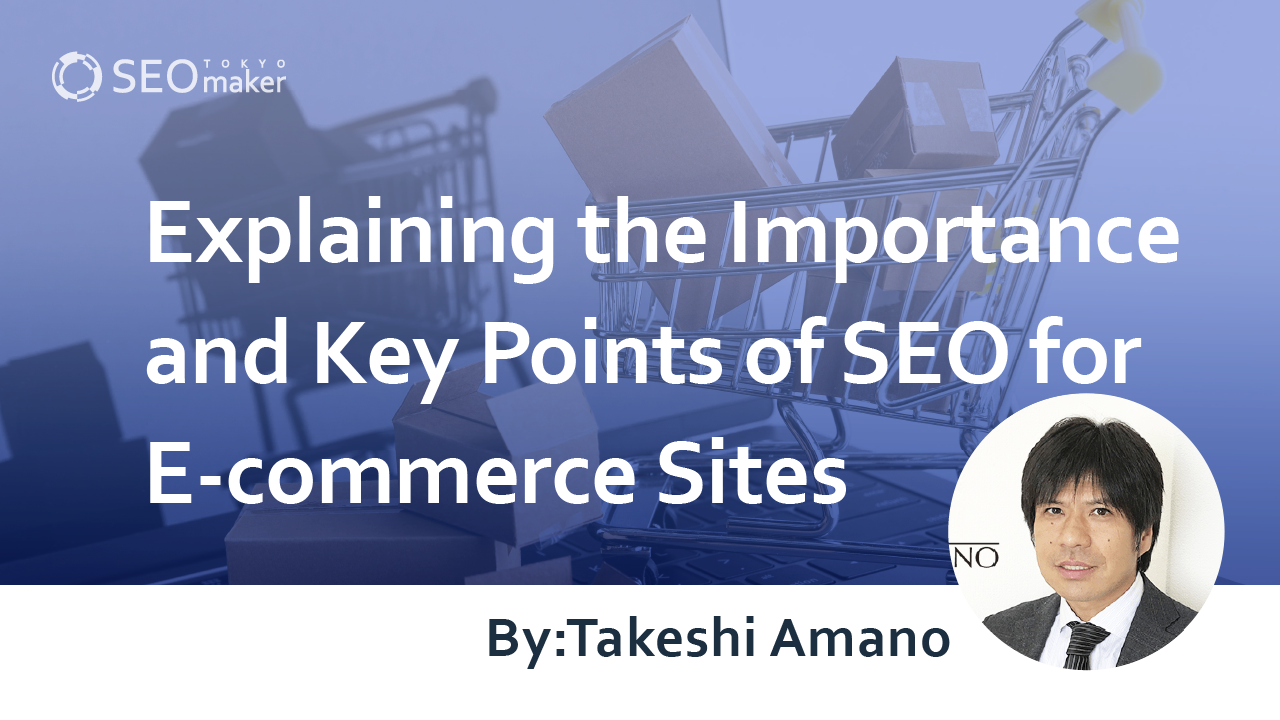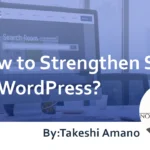The Importance of SEO for E-commerce Sites : Explaining the Key Points
contents
- 1 SEO Strategies for E-commerce Sites
- 2 Strong Growth in Original Brands
- 3 Collecting Backlinks for an E-commerce Site
- 4 Comparing E-commerce Sites with Brick-and-Mortar Stores
- 5 What Should Be Done on an E-commerce Site?
- 6 O2O and Omnichannel Strategies
- 7 Integrating Physical Stores, E-commerce Sites, and Social Media
- 8 Effective Methods for Acquiring Customers
- 9 Summary

The level of SEO competition for an e-commerce site (online shop) can vary depending on the product category, but it is generally a highly competitive field due to the large number of competitors. However, effective marketing and understanding user needs, along with expanding pages beyond just product sales pages, can make it possible to strategize effectively.
To achieve top rankings amid stiff competition, producing original content regularly and staying on top of trends are essential, but fundamentally, a well-designed site structure is crucial.
While there are different types of e-commerce sites, such as those using platforms like Rakuten Marketplace or Yahoo! Shopping, this article will focus on SEO strategies for proprietary sites.
SEO Strategies for E-commerce Sites
While e-commerce sites (online shops) handle many different product genres, or sometimes specialize in just one, it is crucial to categorize products as finely as possible in either case.
Additionally, if there are brands or product series, it’s necessary to consider cross-category strategies (meaning products span more than one category).
Creating seasonal or trend-focused feature pages, as well as including ‘How To’ articles about product usage and selection, can differentiate your site from competitors and lead to sales from article traffic.
Here are four major SEO strategies for e-commerce sites.
POINT
-Divide categories into smaller sections
-Be mindful of cross-categories
-Follow trends
-Answer product-related “How To” questions
Finely categorize products
The main focus of any e-commerce site’s SEO is the product keywords themselves. Due to intense competition, merely posting product descriptions and prices is not enough. It’s essential to break down categories in detail.
For instance, if specializing in bags, create broad categories for men’s and women’s bags and further categorize by type, such as business bags, Boston bags, tote bags, and handbags. This detailed categorization naturally enhances SEO, and creating comparison pages or ranking pages for each category can make the site more favorable to search engines.
Focus on cross-category content
Products often belong to brands or series, making it crucial to facilitate named searches that can directly lead to purchases.
For example, in an online computer shop, manufacturers might include Sony, Microsoft, Fujitsu, NEC, etc., with series like VAIO, Surface, FMV, LAVIE. However, these single terms are challenging to optimize, so it’s advisable to create pages that combine these with specific products, like “Sony Computers.”
Keep up with trends
Beyond product pages, creating feature articles is essential. These pages often lead directly to purchases. It’s crucial to maintain up-to-date content as trend and seasonal keywords can have significant but temporary effects. Trends can stem from various sources, including fashion seen in magazines or TV shows, as well as games and animations. Seasonal events like Christmas or Valentine’s Day, or yearly fashion trends like fall or winter clothing, also influence demand. In 2020, products like masks and sanitizers saw a surge due to the COVID-19 pandemic. Although not directly related to e-commerce, the popularity of the game “Animal Crossing” even spurred interest in stock trading for some.
Even if a trend seems unrelated to your company or products at first glance, it can still present a business opportunity, so it’s crucial to stay on top of trends.
How to Create ‘How To’ Content for Products
Even when customers are interested in purchasing products, they often may not know how to choose or use them. Creating how-to articles related to the products you sell can drive traffic to your product pages, help you rank higher in search results, and ultimately increase sales.
For example, if you sell kimonos or yukatas, you could write articles on “how to wear” them, or for ties, you might cover “stylish ways to tie them.” For scarves, “different ways to wrap them,” and for items like skis or fishing rods, “how to use” them could be topics. Produce these how-to pages in large quantities and feature them on special pages on your site.
Especially with how-to articles, even if they attract little traffic, just having these pages can significantly boost the search rankings of the entire category. It’s highly recommended to produce as many related pages as possible, keeping related keywords in mind.
In practice, there have been cases where deleting a low-traffic how-to page from an e-commerce site caused a sudden drop in search rankings. This indicates that search engines evaluate the relevance of the entire site, not just traffic to individual pages.
Instead of viewing the creation of these pages as a waste of resources because they may not directly lead to sales or attract much traffic, consider them necessary for optimizing the whole site.
Strong Growth in Original Brands
So far, we’ve discussed handling other companies’ products, but if you can create your own original brand, it’s beneficial to actively promote it on your site.
Launching products under a unique brand name and strategizing around them can lead to searches by product name in the future. Original brands are often easier to rank for, and once they reach the top, they tend to stay there, making it easier to maintain traffic.
Moreover, once your original brand products start selling, they may be listed on roundup or comparison sites, which can enhance your site’s reputation through incoming traffic and citations.
Collecting Backlinks for an E-commerce Site
If you have an original brand, collecting backlinks can be relatively easy if the products become popular, as they are unique to your company. However, securing links to your site for other products can be incredibly challenging.
Considering the importance of backlinks for SEO and the difficulty of achieving high rankings for e-commerce sites without them, creating compelling content on feature pages can help garner links from blogs, media, and social media.
In recent times, achieving high rankings through internal optimizations alone has become more challenging, so while creating content within your site is essential, the key challenge to high rankings is how to earn links to that content.
Comparing E-commerce Sites with Brick-and-Mortar Stores
We often hear from those who have launched e-commerce sites but are not seeing sales, seeking consultancy for making their online businesses successful. Here, I’ll share the secrets to success by comparing the roles of physical stores and e-commerce sites.
To state the conclusion upfront, treating e-commerce sites and physical stores as entirely separate entities is a recipe for failure.
In physical stores, promotional activities to attract customers are standard, but with e-commerce sites, there’s a common misconception that customer service is unnecessary. This is a significant pitfall.
Even for e-commerce, the practices commonly executed in physical stores—like attracting customers, customer service, and follow-up—are necessary.
■Understanding the Strengths and Weaknesses of Physical Stores and E-commerce Sites■
Let’s look at the table below to understand the characteristics of both physical stores and e-commerce sites and use this knowledge strategically.
|
Advantages (Strengths) |
Disadvantages (Weaknesses) |
|
Physical Store |
Physical Store |
|
Can physically handle the products, increasing trust. |
Must travel to the store (time required). |
|
Shopping can be a social activity. |
Must carry purchases home. |
|
Immediate product acquisition. |
Limited information available. |
|
Possible price negotiation. |
Hard to compare prices. |
|
Easy returns and exchanges. |
Can’t shop outside of business hours. |
|
Can try on or taste products. |
Sales pressure can be a concern. |
|
No need for personal information. |
Might forget and not repurchase. |
|
Enjoyable store atmosphere. |
|
|
Can receive advice while shopping. |
|
|
E-commerce Site |
E-commerce Site |
|
Shop anytime (no need to go out). |
Lower perceived trustworthiness. |
|
Easy to repurchase from order history. |
Purchasing process can be cumbersome. |
|
Easier to find desired products. |
Cannot try or taste before buying. |
|
Easier to compare prices. |
Shipping costs apply. |
|
Can buy from distant locations. |
Returns are not immediate. |
|
Can refer to reviews. |
Personal information security concerns. |
|
Wide variety and more information available. |
Cash not usable. |
|
Products are delivered. |
Product not immediately received. |
Characteristics of E-commerce Sites
E-commerce is preferable when you want to save time or already know what you want. Recently, the ease of purchasing from smartphones makes e-commerce increasingly suitable. However, some products that sell in physical stores may not perform as well online, especially lesser-known or weaker branded items like accessories, bags, or everyday goods.
Characteristics of Physical Stores
Physical stores have a distinct advantage when customers want to carefully choose products, especially for items like real estate and insurance which are less commonly purchased online.
Additionally, it’s common for customers to gather information about prices and other details from an e-commerce site and then visit a physical store to make their purchase. This underscores the importance of integrating e-commerce sites with physical stores.
Butはいらないです。
Butはいらないです。
What Should Be Done on an E-commerce Site?
For this discussion, we’ll focus on e-commerce sites and omit physical store details. Initially, we’ve observed the differences and features compared to physical stores, but with e-commerce sites, it’s essential to nurture and grow the site.
1.Site Construction: Develop pages thoroughly (categorize main products).
2.Customer Acquisition: Web marketing (SEO, advertising, campaigns).
3.Customer Service: Product planning (increase best-sellers), add categories, and create easy purchase pathways.
4.Customer Retention: Secure repeat customers, direct mail, campaign notifications, newsletters, etc.
We will foster the site through these four cycles. Start by determining which product categories to focus on and develop attractive pages for those products.
Once that’s in place, focus on customer acquisition. Implement SEO strategies for the e-commerce site and launch advertising to increase site traffic.
To ensure that customers who have made a purchase return, use strategies like newsletters with coupons and membership benefits to encourage them to become repeat customers. Relying solely on new customers won’t substantially increase sales.
Successful stores always have a strong base of repeat customers. Once you have a stable customer base, aim to develop at least ten best-selling products and continuously add successful items to your categories to enhance sales.
This cycle of improving sales is crucial to the continued success of your e-commerce site.
O2O and Omnichannel Strategies
If you operate both an e-commerce site and a physical store, it doesn’t matter where the sales are coming from, as both are part of the O2O (Online to Offline) strategy.
The omnichannel approach involves not segregating promotional efforts but rather integrating them to increase contact frequency with customers and drive purchases. For example, a customer might see a sign at a physical store, become interested, search online, check the product on an e-commerce site, and ultimately visit the physical store to make a purchase—this is a prime example of an omnichannel strategy.
POINT
What is O2O?
O2O stands for Online to Offline, involving strategies that use the internet to drive traffic to physical stores. In other words, it’s a strategy to drive traffic to physical stores through online efforts and create synergistic effects.
POINT
What is Omnichannel?
Omnichannel is a strategy that involves interacting with customers through multiple touchpoints—not just at physical stores or online but across various platforms such as social media, smartphones, computers, flyers, catalogs, and call centers. This approach ties all these channels together to provide a seamless customer experience.
Integrating Physical Stores, E-commerce Sites, and Social Media
Once you grasp the concept of an omnichannel strategy, the goal is to keep customers engaged across all platforms. Customers can easily forget about a store or product if no action is taken.
For instance, you could hand out flyers to customers who visit your physical store to introduce them to your e-commerce site. Conversely, you could use social media to draw customers who have shopped online into your physical stores by promoting special in-store campaigns.
While the strategy for social media is a topic in itself, it’s effective to use social media as a “hook” to introduce products and campaigns, enticing customers to visit your e-commerce site or physical store.
It’s crucial to include links to product pages in your posts, making it easy for interested users to jump directly to the purchase page. Building a seamless pathway from social media to purchase is essential.
Effective Methods for Acquiring Customers
Nowadays, it’s common for customers to see a product in-store and buy it online later, or vice versa—browse online and then purchase in-store. This has increased the number of users who shop both online and offline.
Therefore, introducing your e-commerce site to customers who visit your store and encouraging online purchasers to visit your physical store are effective strategies.
For example…
- -Encourage in-store customers to register their email addresses through survey responses or while signing up for a loyalty card. ➡ Send them the latest store updates and information about products available on your e-commerce site.
- -Notify online purchasers about in-store-only sales campaigns to drive traffic to the physical store.
- -Offer general buyers gifts or special coupons to convert them into loyal customers.
- -Launch coordinated campaigns across your e-commerce site, flyers, physical stores, and social media to create a comprehensive marketing environment.
The key to success is to constantly consider the consumer’s psychology and implement a plan ➡ promote ➡ assess results ➡ make improvements (PDCA cycle). Continuously refining your strategies through trial and error is crucial.
Summary
If you’re unsure about handling these aspects, our company has consultants specializing in e-commerce who can help. Feel free to contact us for a consultation.










![What is a Description? Explaining the Meaning, Writing Style, and Changing Word Count – [2023 Edition]](https://www.switchitmaker2.com/en/wp-content/uploads/2024/09/what-is-description.webp)










